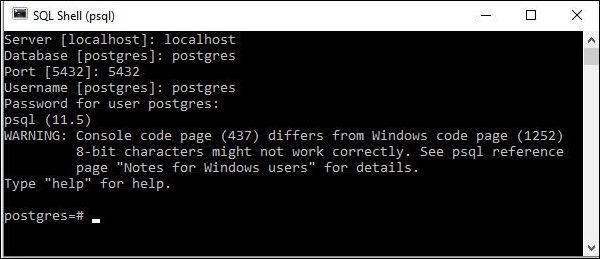
- Python Data Access - Home
- Python MySQL
- Python MySQL - Introduction
- Python MySQL - Database Connection
- Python MySQL - Create Database
- Python MySQL - Create Table
- Python MySQL - Insert Data
- Python MySQL - Select Data
- Python MySQL - Where Clause
- Python MySQL - Order By
- Python MySQL - Update Table
- Python MySQL - Delete Data
- Python MySQL - Drop Table
- Python MySQL - Limit
- Python MySQL - Join
- Python MySQL - Cursor Object
- Python PostgreSQL
- Python PostgreSQL - Introduction
- Python PostgreSQL - Database Connection
- Python PostgreSQL - Create Database
- Python PostgreSQL - Create Table
- Python PostgreSQL - Insert Data
- Python PostgreSQL - Select Data
- Python PostgreSQL - Where Clause
- Python PostgreSQL - Order By
- Python PostgreSQL - Update Table
- Python PostgreSQL - Delete Data
- Python PostgreSQL - Drop Table
- Python PostgreSQL - Limit
- Python PostgreSQL - Join
- Python PostgreSQL - Cursor Object
- Python SQLite
- Python SQLite - Introduction
- Python SQLite - Establishing Connection
- Python SQLite - Create Table
- Python SQLite - Insert Data
- Python SQLite - Select Data
- Python SQLite - Where Clause
- Python SQLite - Order By
- Python SQLite - Update Table
- Python SQLite - Delete Data
- Python SQLite - Drop Table
- Python SQLite - Limit
- Python SQLite - Join
- Python SQLite - Cursor Object
- Python MongoDB
- Python MongoDB - Introduction
- Python MongoDB - Create Database
- Python MongoDB - Create Collection
- Python MongoDB - Insert Document
- Python MongoDB - Find
- Python MongoDB - Query
- Python MongoDB - Sort
- Python MongoDB - Delete Document
- Python MongoDB - Drop Collection
- Python MongoDB - Update
- Python MongoDB - Limit
- Python Data Access Resources
- Python Data Access - Quick Guide
- Python Data Access - Useful Resources
- Python Data Access - Discussion
Python PostgreSQL - Database Connection
PostgreSQL provides its own shell to execute queries. To establish connection with the PostgreSQL database, make sure that you have installed it properly in your system. Open the PostgreSQL shell prompt and pass details like Server, Database, username, and password. If all the details you have given are appropriate, a connection is established with PostgreSQL database.
While passing the details you can go with the default server, database, port and, user name suggested by the shell.

Establishing connection using python
The connection class of the psycopg2 represents/handles an instance of a connection. You can create new connections using the connect() function. This accepts the basic connection parameters such as dbname, user, password, host, port and returns a connection object. Using this function, you can establish a connection with the PostgreSQL.
Example
The following Python code shows how to connect to an existing database. If the database does not exist, then it will be created and finally a database object will be returned. The name of the default database of PostgreSQL is postrgre. Therefore, we are supplying it as the database name.
import psycopg2
#establishing the connection
conn = psycopg2.connect(
database="postgres", user='postgres', password='password', host='127.0.0.1', port= '5432'
)
#Creating a cursor object using the cursor() method
cursor = conn.cursor()
#Executing an MYSQL function using the execute() method
cursor.execute("select version()")
# Fetch a single row using fetchone() method.
data = cursor.fetchone()
print("Connection established to: ",data)
#Closing the connection
conn.close()
Connection established to: (
'PostgreSQL 11.5, compiled by Visual C++ build 1914, 64-bit',
)
Output
Connection established to: ( 'PostgreSQL 11.5, compiled by Visual C++ build 1914, 64-bit', )